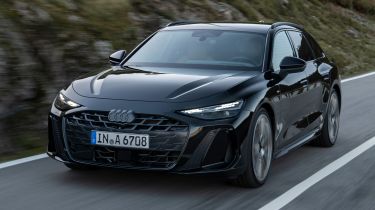Audi A6 Avant review
Audi’s new premium executive estate has gone all ‘lifestyle’ with a very sleek new look, but it hasn't really come at the expense of practicality

Our opinion on the Audi A6 Avant
Audi has made the decision to make its new A6 Avant more lifestyle-orientated this time around, capitalising on style rather than outright practicality. If haulage is still key for your needs, the larger and more efficient Mercedes E-Class might deliver the goods, but if not, the Audi’s near-shooting brake stance and luxurious cabin more than make up for it. Audi knows that its customers with families buy SUVs, so has made its new A6 Avant the brand’s new style icon.
| Key specs | |
| Fuel type | Petrol, diesel MHEV |
| Body style | Estate |
| Powertrain | 2.0-litre four-cylinder turbo petrol 2.0-litre four-cylinder turbo diesel, MHEV |
| Safety | TBC |
| Warranty | 3 years, 60,000 miles |
About the Audi A6 Avant
The full-sized Audi A6 Avant has been a stalwart in the executive segment for the best part of 60 years, and while it hasn’t quite dominated the scene like the BMW 5 Series and Mercedes E-Class, it has traditionally represented the best and brightest of Audi’s technical knowhow. But in 2025, things are a little more complicated. We’ve already seen and driven a brand new and all-electric A6 Avant e-tron only six months ago; and yet this is another brand new-A6 Avant. Let’s explain.
Audi made the choice a little while back to designate its future EV models with even numbers and ICE cars odd, meaning that when Audi released its bespoke, all-electric executive model, it was called the A6 e-tron.
Used - available now
This means the new generation was meant to be called A7 Avant, hence the sleek silhouette. But this idea backfired slightly with the smaller A5 models, so Audi decided instead to stick with the A6 moniker and offer two entirely different cars with the same name, separated only by a couple of badge modifiers – TFSI and TDI in this case depending on the engine – and the fact it looks, feels and drives very differently to the all-electric A6 e-tron.
So consider this the new Audi A6 Avant that it should have been all along, and boy what a change. Sitting on a heavily revised version of the previous car’s PPC platform, the hi-tech architecture is designed to house the latest petrol and diesel engines, but more specifically a range of plug-in hybrid models that will also power the future RS 6 Avant.
Prices for the TFSI petrol-powered car kick off at £52,210, with the TDI diesel and its standard quattro four-wheel-drive system bringing this up to £56,780. Upgrade to S-Line trim and it will cost an extra £2,100, with an Edition 1 costing £8,000 more than the base price of the entry-level versions.
Performance & driving experience

| Pros | Cons |
|
|
Audi will launch the A6 Avant with a limited range of engines to begin with, but the line-up will quickly expand in the coming months. For now this means that only the two least powerful options will be available in the UK, with neither being particularly impressive when it comes to power or efficiency. The pair of four-cylinder engines – one petrol and one diesel – share a power figure of 200bhp, but diverge quite dramatically after this point.
The petrol is relatively straightforward; the 2.0-litre four-cylinder turbocharged unit is the same one that has been found in Audis and Volkswagens since the early 2000s, and while it has been significantly updated over the years, the basic design remains. That’s no bad thing, because inherently this engine is responsive and refined. But unlike a 2005 Mk5 Golf GTI with which it shares its basic output, the motor now needs to motivate 2,005kg, which isn’t easily hidden. The engine is connected to a seven-speed dual-clutch transmission and is front-wheel drive only.
The diesel, by contrast, includes Audi’s new MHEV Plus system which finds a middle ground between the old mild-hybrid systems, which didn’t do a whole lot, and full hybrid systems that do. It adds a worthy punch of torque to the driveline when needed, thanks to a small e-motor mounted directly to the engine, and can even drive the wheels for a short period of time on its own at low speeds.
This helps streamline the diesel’s operations, while supplementing its 400Nm of torque. The diesel powertrain is only available with quattro all-wheel drive in the UK, and once again is put through a seven-speed dual-clutch transmission.
As is quite often the case with core range models for big brands such as Audi, how the A6 Avant drives largely depends on how it is specified. The two models we drove on the international launch were at the extreme ends of this spectrum, and showed that while no A6 drives poorly, the lower-specified models with smaller wheels felt the most suited to its powertrain.
Performance, 0-60mph acceleration and top speed
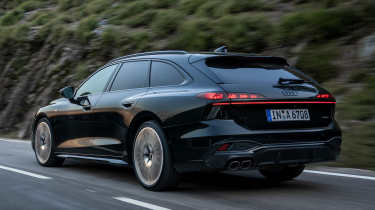
Big kerbweights and small power figures at the lower end of the executive-car range means that no A6 – for now – offers much bite. The A6 TFSI will take a rather long-winded 8.2 seconds to go from 0-62mph and tops out at 141mph, but in the real world it does feel spritelier than that, thanks to a solid and easily negotiable 340Nm of torque, which is available from just 2,000rpm.
The diesel’s surplus of torque and four-wheel system wipes reduced the 0-62mph time to just seven seconds. However, in terms of feel, the opposite is true when it comes to on-road performance. The extra torque, while undoubtedly useful, is only available at a relatively high 3,800rpm, so you seem to need to work the A6 more than expected to actually build up some speed.
The quattro all-wheel drive set-up adds traction, but its positive effect will only really be felt in cold or slippery conditions. Instead, the diesel feels relatively ponderous and this is also likely added to by the car’s conservative transmission mapping. This is no doubt designed to keep the engine’s revs low for the sake of fuel consumption, but is exactly where the available torque is not.
This shortage of performance in the range won’t last long, though, because the line-up will soon expand with new PHEV models that will pack considerably more power, plus high-performance S and RS6 range toppers.
Town driving, visibility and parking

The A6’s sleek shape in combination with the high dashboard can initially make the A6 Avant feel a touch intimidating from the wheel, but thanks to clear and responsive steering it quickly becomes an intuitive car to drive. The A6 is big, and especially wide which can mean that you do need to think twice (or refer to the excellent camera system) when squeezing down busy urban roads.
There’s plenty of adjustment to the driver’s seat that can hoist you up to see over the tall dash. Once you are up there, the car has relatively good manoeuvrability, even without the optional rear-wheel steering. The gearbox is very smooth, and regardless of the petrol or diesel engine, both are refined when you’re just pootling about.
Cars fitted with the larger 21-inch wheel design had a little bit of trouble containing the ride at low speeds, sometimes crashing into ridges in the road and feeling like it wouldn’t take too much of a pothole to see the wheel and tire get damaged. This improved considerably on smaller 20-inch rims, though.
Those slim rear windows and the low roof do make parking trickier than most rivals, thanks to limited visibility, but the camera and automatic parking systems on these cars quickly make it easy to slip into tight car parks. Yet there is no way of getting around the fact that the A6 is a big car with a large footprint.
B-road driving and handling
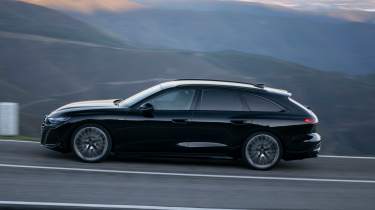
No large executive estate really has a mandate to drive with any real sense of engagement, but being confidence-inspiring at high speeds is something that this type of car needs to purvey, and the A6 doesn’t disappoint.
The steering is a particular highlight, because it’s accurate and has good amounts of feel and feedback. This helps you thread the car along twisty roads with confidence, even if the lower-powered models we’re driving don’t do much to stretch the chassis’s capability.
We drove cars both with steel springs and two-wheel steering, or air springs and rear-wheel steering – the latter not yet available in the UK. We found that it was actually the base car on the standard suspension and smaller 20-inch wheels that felt more connected to the road, without giving anything away in terms of ride comfort.
Models with the air suspension also had to handle larger 21-inch wheels, which was dealt with well, but there was definitely a sense of those bigger wheels and a slightly more ponderous feel to the drive as a result. The rear steering added some level of agility, but once again this feels unnecessary for low-powered models.
Motorway driving and long-distance comfort

It’s here that the A6 Avant will need to shine, and by and large it really does – even on the largest 21-inch wheels. The A6’s soft suspension, yet firm steering made for an extremely comfortable ride without the car feeling nervous or twitchy. The steering ratio is quick, without going to the extremes of rivals from BMW or Mercedes, but this crucially made the motorway experience very chilled out, while the exceptional refinement from both road noise and powertrain drone improved matters further.
Under hard acceleration the diesel can grumble a little bit, and it does need to be worked surprisingly hard to access its extra power, due to the high engine speeds required to reach peak torque. As such, while the chassis and cabin refinement scream luxury, both these low-powered engines make a little too much noise of their own; expect six-cylinder and plug-in hybrid models to feel more relaxed on the motorway, especially at German-style high speeds.
| Model | Power | 0-62mph | Top speed |
| Audi A6 Avant TFSI | 200bhp | 8.2 seconds | 144mph |
| Audi A6 Avant TDI Quattro | 200bhp | 7.0 seconds | 147mph |
MPG & running costs
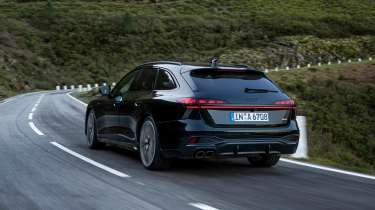
| Pros | Cons |
|
|
Putting it simply, Audi’s on-paper efficiency figures are not exactly ambitious, which makes the A6 look like it trails a couple of its key competitors before it’s even turned a wheel.
The diesel, which should be the efficiency leader, is rated at a rather underwhelming 48.7mpg on the combined WLTP test. This doesn’t compare favourably with its key rival, the Mercedes E-Class Estate in the equivalent E 220 d form, which is capable of up to 10mpg more. It is worth noting that the Audi has Quattro all-wheel drive as standard, whereas the Mercedes is rear-wheel drive only.
It is also worth recording that we matched the A6’s official MPG figure during our test drive, and thanks to the help of the MHEV Plus system, the numbers didn’t free-fall in town as they can sometimes do in a modern diesel.
Matching the TFSI petrol’s claimed figure of 37.1mpg was also possible. In fact, we quite easily beat that number over a mix of town and country roads, but we suspect that with a heavier foot that economy would quickly plummet. Compared with an equivalent BMW or Mercedes, the Audi’s MPG figures are about on track.
| Model | Economy | CO2 | Insurance group |
| Audi A6 Avant TFSI | 37.1mpg | 173g/km | NA |
| Audi A6 Avant TDI Quattro | 48.7mpg | 153g/km | N/A |
Tax
All A6s will fall into the new government VED brackets, with the TFSI coming in at 173g/km. This puts it into a high bracket, with an additional £1,360 added at the time of purchase. After this it exceeds the luxury car threshold of £40,000, meaning the VED charge will be £620 per year. This will revert to the standard £195 fee after five years. The Audi is in the 37 per cent Benefit-in-Kind (BiK) tax bracket for company-car drivers.
Depreciation
Audi generally suffers higher levels of depreciation than rivals from BMW and Mercedes, but it’s not as bad as comparable EVs, which are struggling to retain values the minute they drive off the forecourt.
Interior, design & technology
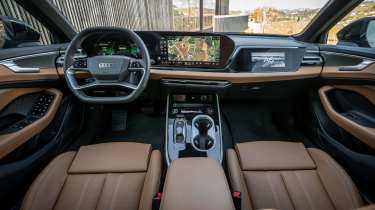
| Pros | Cons |
|
|
Audi has long been a cornerstone brand when it comes to interior quality and design, but its models of late haven’t had quite the same lead as their ancestors did in decades past. This all-new A6 Avant is Audi’s chance to write that wrong and re-establish its credibility, and while not perfect, it gets close to achieving that goal.
Interior and dashboard design
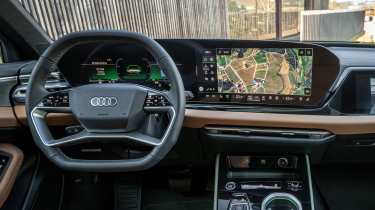
As is so often the case when it comes to new car interiors, it’s the brand’s choice of layout for the digital interfaces that drive its overall design. In the new A6, the main touchscreen and driver’s information display are mounted under the one curved housing that doesn’t just take up a lot of physical space, but visual space, too, dominating the whole cabin.
Take into account the central air vents and a few layers of trim pieces and there’s almost no more interior left to design. Yet what is in the voids is good, with a curvy and otherwise well executed combination of shapes and graphics. Referencing previous A6 models is a hoop around the base of the windscreen, which also integrates an ambient lighting strip that also flickers green at each end when the indicators are selected.
Materials and build quality
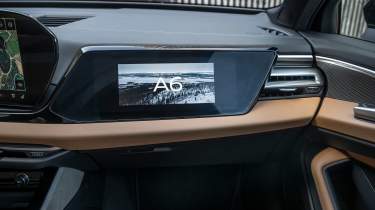
These vary depending on model and trim, but most of the touchpoints such as the steering wheel, door handles and indicator stalks feel suitably premium, if not luxurious. There are a few material oversights, such as the cheap-feeling gear selector, and the fact it’s surrounded in gloss-black plastic that will potentially be scratched by watches or bracelets. The cabin is superbly built, though, and we found that it compares strongly against the BMW 5 Series’ extremely well appointed cabin, and feels miles ahead of the Mercedes E-Class.
Infotainment, sat-nav and stereo
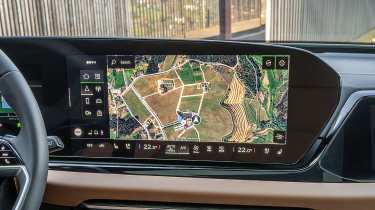
To the uninitiated, Audi's latest technology interface can feel a little bewildering and overcomplicated. Separate out the elements and you’ll find some clarity, though, starting with the driver’s display. Despite arguably inventing the digital instrument cluster, Audi’s new system can be a little frustrating, because there doesn’t seem to be a whole lot of variability in its layout.
The brand’s famous virtual cockpit and the large-format Map view doesn’t really exist in this new era. Instead there’s a single round element in front of you with various active safety icons, but little more. If your navigation is active, next-turn information is large and relatively clear, but it would be nice to have a clearer map view in front of you.
That central drive element isn’t a traditional rev-counter, despite these powertrains being ICE or MHEV; instead there’s a power percentage read-out that is largely useless. Select Sports mode and a rev counter does appear, but it’s fairly innocuous and can be tricky to read. You can select a layout to minimise all the visual clutter, which leaves a large black space in front of you.
Depending on the specification, a large and very high-resolution heads-up display sits above this, and offers generally the same information repeated in your eyeline. Once again, the standard view is rather cluttered and doesn’t offer much useful on-the-fly information, but you can select a simplified view option here, too.
We then get to the main touchscreen display, which is very large but also very clear. Directly to your right (on left-hand-drive cars) is a small shortcut section which will take you directly to any of the car’s main functions, and the main home screen has a customisable layout that shows any key information you might need on the one page. Select any of those tiles and you’ll be taken into each area’s full functionality. The air-conditioning controls are accessible from the main screen on a static bar at their base, but for deeper functionality than temperature or other main controls, you’ll need to access a separate climate-control screen.
All of the cars on test featured a Bang & Olufsen sound system, which sounded great. True audiophiles will note that ultra high-end systems available in rivals do have a little more grunt, but these are minimal differences and often cost a whole bunch more as a standalone optional extra.
Boot space & practicality
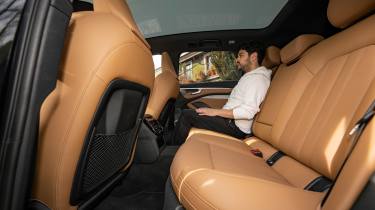
This is an Avant, so you’d think the boot means everything, but this isn’t quite the case with the new A6. Audi has confessed that the rise of SUVs means that families and those after ultimate loadspace now generally gravitate towards models such as the Q7, so Audi’s decision to create a sleek, design-led model has its drawbacks.
| Dimensions | |
| Length | 4,990 |
| Width (inc mirrors) | 1,880 |
| Height | 1,640 |
| Number of seats | 5 |
| Boot space | 403 litres |
Dimensions and size
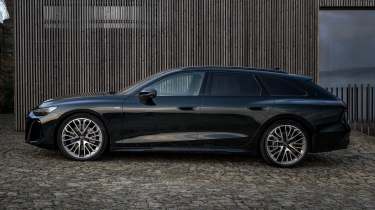
Audi quotes a boot space of 503 litres, which is nearly 150 litres down on the significantly boxier and more upright Mercedes E-Class. This can be increased to 1,564 with the second row of seats lowered, but even then the volume is still nearly 300 litres down on the Mercedes.
The actual boot space itself is square, features a small amount of under-floor storage and comes with plenty of hooks and other little additions to make it as versatile as possible. The back seats drop in a 40:20:40 split, with the centre section lowering independently to allow for long items such as skis to fit with four passengers in place.
Driving position, seats & space in the front

There’s a good amount of variability to the driver’s seating position, but visibility out can be hampered by both the tall digital interfaces and relatively narrow windows. There is plenty of space for larger drivers, though, and all the key touchpoints, such as the seats and where you rest your knee against the centre console are padded and very comfortable.
Seats & space in the back
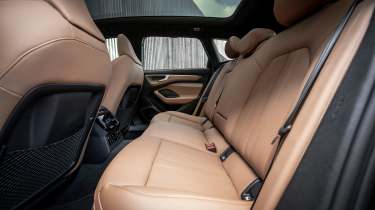
The rear seats have a similar issue to those in the front due the small windows, but overall space is fine, if not massive. Rivals with taller bodies such as the Mercedes E-Class and even the BMW 5 Series have a little more legroom and a less intrusive centre hump. There are lots of provisions back there, though, such as USB-C charge points and map lights.
Boot space
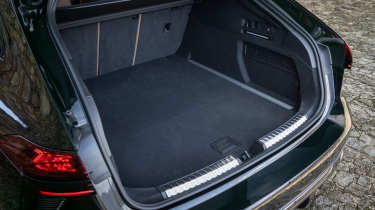
As mentioned the boot space is 503 litres and there’s a ski hatch, plus 40:20:40-split folding rear seats that can be lowered individually.
Reliability & safety

| Pros | Cons |
|
|
Audi will launch the A6 Avant with a full roster of active and passive safety kit under one umbrella, called the ‘Drive and Park’ assistance package. This includes adaptive cruise control, speed sign recognition and alert, a rear camera and a parking assistant. There’s also lane departure warning, cross-traffic alert, swerve assist, front turn assist and an emergency braking function.
| Key standard safety features | Euro NCAP safety ratings |
|
|
Buying and owning
- Best buy: Audi A6 Avant TFSI
For now, we think the petrol will be the best choice for private buyers, because it’s less expensive, nearly as efficient and sweeter to drive than the diesel. If mega miles are on the agenda, though, the diesel still has its advantages. Business buyers will find the tax-friendly PHEV models due in the next few months to be much more suited to their needs, thanks to a reduced tax bill, with the added benefit of excellent efficiency gains if it’s regularly kept topped up with charge. For the lowest running costs for business users, though, Audi’s own A6 e-tron Avant might just pip the ICE model.

